|
|
|
Ancient Europe was a place quite different from that which is familiar to modern Europeans. The European hinterland - Gaul (roughly modern France), the British Isles, and the vast stretches of what is now Germany, Austria, Poland, Hungary, etc.- was peopled by groups of tribes of varying origin which can nevertheless be grouped according to a rough ethnic label:
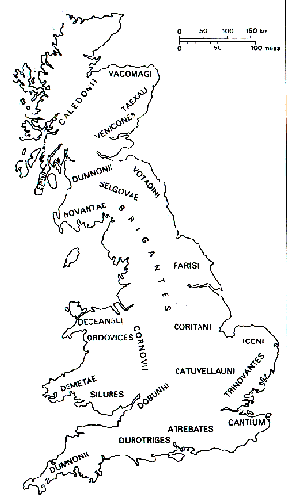
In contrast to the hinterland were the cultures of the Mediterranean basin. By the time of the period under discussion (ca. 100B.C-43A.D) the Mediterranean world had been drawing together under successive Hellenistic Greek, Punic-Carthaginian and then Roman influences. These cultures were urbanised, political and, especially in the case of the nascent Roman power, militarised. By 146B.C. , Rome had destroyed her maritime rival Carthage and embarked on a drawn out process of gaining hegemony, if not direct rule, over the various Mediterranean states. Rome was a consumer economy, and like the rest of the ancient Mediterranean was dependent on the triad of grain, olives and viniculture. Grain importation became increasingly important and political, as Rome's urban population received grain handouts subsidised by the state, and more importantly as her military commitments, and therefore her army, became larger. The search for grain to feed her armies and the need for the raw materials of war, such as metals and animal hides prompted Roman traders to look to inland Europe for these materials: A Phocaean Greek colony had existed at Massilia (mod. Marseilles) since the eighth century B.C. It was a relatively simple matter for Rome to tap these markets, especially since treaty relations had existed between Rome and Massilia for some time. Rome would get raw materials, grain and slaves; barbarian aristocrats would get prestige goods like wine held in amphorae and fineware drinking accessories.
In discussing the role of the British tribes in the amphorae trade of this period, we can discern three main periods (mainly for the sake of convenience, and not based on any hard and fast scholarly divisions): The pre-Caesarian, being roughly 100B.C. to C. Julius Caesar's military expeditions in Gaul and Britain; the post-Caesarian, extending from Caesar's British expeditions of 55-54B.C. until ca. 10B.C., the generally accepted date for the end of the Dressel 1 form of amphora; and the pre-Claudian, corresponding to the first half of the first century A.D. before the emperor Claudius' full scale invasion of Britain.
Since 121 B.C., with the establishment of the Roman province of Gallia Transalpina (in southern Gaul), Roman traders had been able to bypass the Straits of Gibraltar and look west via the River Garumna (mod. River Garrone) in search of commodities such as British tin. The distribution of Dressel 1A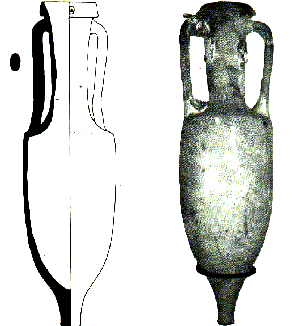 (See plate A,adjacent) amphorae along this corridor soon after Publius Crassus' reconnaissance expeditions (late 90s B.C.) is testament to the growing importance of the trade (Cunliffe in McCready & Thompson (eds.) 1984:pp 3-4).
(See plate A,adjacent) amphorae along this corridor soon after Publius Crassus' reconnaissance expeditions (late 90s B.C.) is testament to the growing importance of the trade (Cunliffe in McCready & Thompson (eds.) 1984:pp 3-4).
Falernian and Caecuban wines from the wine growing areas of Latium, Campania and Etruria in Italy would have embarked from Italian ports such as Ostia and made for the Transalpine colony at Narbo Martius, or for Arelate. From here, it was a short haul to the West Coast via arterial rivers (Galliou in McCready/Thompson, '84 :pp 26-27). Both Caesar in his commentaries on the Gallic campaigns and the Roman geographer Strabo mention the Armorican tribe of the Veneti as controllers of this trade to Britain (hence Caesar's war against them in the 50s B.C.). However, archaeological finds of Armorican coins in southern Britain reveal the presence only of their near neighbours, the Coriosolites and Venelli (Galliou, McCready/Thompson '84:pp 28). Daphne Nash posits that the Veneti were only actively in control of the southern half of this western trade route (McCready &Thompson '84:pp 102)
The major concentration of Dressel 1A amphorae in this period in Britain is around Hengistbury Head, Dorset, in the territory of the Durotriges tribe. This site was conveniently close to the Coriosolitan port at Alet in northern France (Collis 1984:pp 162)and is well sheltered and recognisable from the sea (Cunliffe 1978: p67). At least twelve Dressel 1A have been identified at this site, while other examples have been found at Knighton, Isle of Wight, at Poole Harbour, Dorset and at Carn Euny, Cornwall (D.F. Williams in Howard and Morris (eds.) B.A.R.120, 1981: p125)
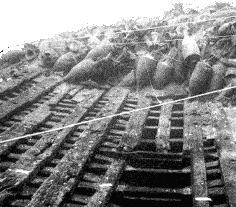
For Cunliffe (1978: p67) the relative scarcity of Dressel 1A on the Armorican peninsula, together with shipwreck finds of the period - for example the Belle Ille shipwreck - along the route, is suggestive of direct contact between Roman merchants and central southern Britain. Other scholars are less willing to go so far. Nash (McCready/Thompson 1984: pp93-94) is of the opinion that the relationship between Armorica and central southern Britain at this time was one of a strong "core community" drawing its periphery into a dependent relationship. On this model, the British corn, hides, metals and slaves mentioned by Strabo would only have reached Roman markets through Armorican intermediaries, and Roman wine amphorae would only reach Britain via the same channel
The aftermath of Caesar's British campaigns left some southern tribes, at least formally, tribute paying parts of the empire (Salway 1981: p42). In reality, however, the treaties concluded with the Catuvellauni and Trinovantes of the south east left some room for manoevure (as later Catuvellaunian expansion suggests). The treaties also started a process of re-orientation in British trade. The south central theatre of commerce around Durotrigan territory now became somewhat of a backwater, while the south east enjoyed profitable relations with Roman controlled Gaul and Belgica.
Parallel to these developments was the changeover from the Dressel 1A amphora form to Dressel 1B (See plate C, below)
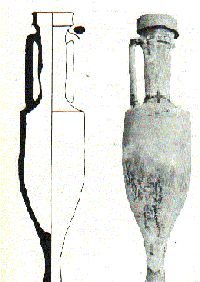
As Galliou points out (McCready & Thompson 1984: pp29-30), the latter form had been common on the continent since around the 70's B.C. onwards, yet only appears in Britain after the 50's B.C. What it appears we are dealing with are two differing amphora forms in two different areas in two distinct periods (There are exceptions to this, however; as in the presence of Dressel 1A on a site at Braughing, Hertfordshire, - see Williams in Howard & Morris '81: pp125).
Archaeology has for some time recognised a distinctive "Aylesford-Swarling" culture in the south east of Britain at this time. This culture, and associated "Welwyn type" burials north of the Thames were formerly considered by scholars to be an influx of Belgic peoples from the continent as a result of the conquest of Gaul. This is now called into question, with Cunliffe pointing to the lack of a secure pre-Caesarian phase for this culture and associating it with the proximity of Roman trade networks, especially since in the Augustan period the Roman theatre of war against Germanic tribes was conveniently close to the south east of Britain and acted as a "commercial zone" for raw materials (McCready & Thompson '84: pp12-16). These south eastern tribes, therefore, were well placed to profit from Roman consumer and military needs. In addition, Galliou stresses the importance of the Rhine-Rhone river corridor in trade at this time, and Roman merchants were probably present in Britain (McCready/Thompson '84: p 28).
Meanwhile, the central southern area of trade appears to dry up. This is perhaps attributable to Caesar's actions against the Veneti and other tribes, whom Caesar comments - De Bello Gallico IV. 20- had received armed assistance from British warriors.
Despite Caesar's attempts to create a balance of power between the south eastern British tribes, the ensuing years saw the gradual encroachment of Catuvellaunian influence across the south and into the midlands (Salway 1981: pp42-45). If the evidence of the spread of Catuvellaunian coinage is indicative of political or cultural influence (and this is by no means clear), then this tribe was dominant in the south east. It appears that the Trinovantes were strongly under their yoke, contrary to Rome's wishes (See Salway 1981: pp 51-52 for Augustus relations with Britain). John Collis (1984: p167) points out that there appears to be a shift in Dressel 1B concentrations in this period, in that in the period immediately after Caesar's expeditions, the main concentration is around Braughing, Herts, while by the time of Augustus' German campaigns the main incidence of Dressel 1B is around Camulodunum (mod. Colchester). According to Collis, the Catuvellauni-Trinovantes may have held the monopoly of trade with the empire at this time.
The influence of the Catuvellauni may have been such that they could supply most of the raw materials that Rome desired. Salway (1981: pp59-60) takes the presence of Italian, Gaulish and Gallo-Belgic pottery in the territory of the Dobunni tribe, together with a corresponding lack of Catuvellaunian coins in the same area as an indication of an "understanding" between these two peoples. Again it is important to note that the evidence of Celtic coin types is equivocal, but it may be that the Dobunni were the intermediaries who provided the Catuvellauni-Trinovantes with the metals that were so needed, from the south west.
By about 10 B.C. the Dressel 1 amphora form died out in favour of other forms (Galliou, McCready/Thompson '84: p30). Wines from other areas of the empire were challenging the dominance of Italian wines, and amphora forms changed accordingly. Furthermore, in the next period, it was not just wine amphorae that were reaching British shores.
In the final period under discussion, archaeology, fabric analysis and petrology reveal a wider, and sometimes confusing, variety of amphorae reaching Britain. The names attached to the amphorae of this period reflect the increased scope of importation. Thus, amphorae are named either after the scholar who first defined the typology (for example, Dressel 2-4), or after a particular excavation (as in Camulodunum 185A)
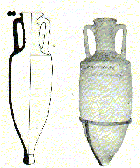
At this time, trade in the south east of Britain shows the signs of continuing to be profitable. As well as the importation of wine, the market now widened to include the importation of olive oil and garum (fish sauce). For example, excavations at Verulamium (mod. St. Albans) produced, in burial no. 272, an almost complete Dressel 2-4 amphora (See plate D, adjacent), dated to the late Augusto-Tiberian period. Analysis of this amphora suggested a Campanian origin, yet it probably contained olive oil rather than the expected wine. The same site produced examples of Rhodian amphorae, and sherds of Camulodunum 185A from southern Spain. The latter contained a sweet liquid made from boiled down must, termed defretum (Stead and Rigby 1989: pp115-116).
At the Lexden tumulus, Colchester, four Dressel 1B were found with ten Dressel 2-4 and one Rhodian. As Williams points out, the latter two types were only produced after around 15B.C., and analysis suggested an Italian origin, not Spanish. Southern Spanish amphora forms did turn up at Camulodunum in the period between 10-43A.D.,however.
Skeleton Green in Hertfordshire produced a rather bewildering array of amphorae or amphora fragments.
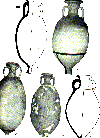
Dressel 20, which usually contained olive oil, made up the largest percentage by weight here (36.4%)closely followed by Dressel 2-4 (24.4%), Dressel 7-11 (usually holding fish products-18.1%: See plate E, adjacent) and even the comparatively rare Dressel 6 (7.9%). Scholars are unsure if this latter held wine or olive oil (see Peacock, McCready/Thompson '84:pp 39-40; Partridge 1981:pp 199-204, tables VI and VII).
The Rhine-Rhone trade route, it appears, was still flourishing. Rome still needed raw materials and British aristocrats still had a taste for Mediterranean goods, despite any anti-Roman protestations (Salway 1981:pp 56-61). The market must have still been lucrative, despite the evidence of Strabo, who comments that the Britons submitted to duties on imports and exports (Geography IV.v.3). Furthermore, Rome was still active against the German tribes, with Tiberius' general and relative Germanicus in command.
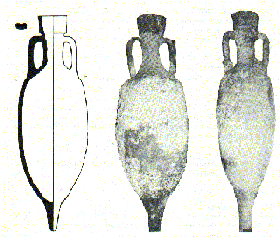
The central and south western areas of Britain appears to regain some of its trading power in this period. There appears to be a concentration of the Dressel 1 Pascual 1 amphora form (See plate F, adjacent), which originated in the Catalan region of northern Spain, an area praised by Martial (Xiii, 118) for its wine (Williams, Howard/Morris B.A.R. 120, 1981:p 128). Amphorae or sherds of this type are attested at Hengistbury Head and Cleavel Point, and at Bagendon, Gloucestershire dated between 20-50 A.D. Examples have also been found at Knighton, Isle of Wight and Pounbury, Dorset. Galliou has pointed out that Dressel 1 Pascual 1 and Dressel 2-4 were often produced in the same area, or even the same kiln site, in Spain; yet in Britain, the former type concentrate in central and south western areas, while the latter are more common in the south east (Galliou, McCready/Thompson '84:p 31). Why this should be is not clear.
The overall picture in this final period is less clear cut than that of the distribution of Dressel 1 forms in the previous century, as more amphora types were imported to Britain. Despite examples of north Spanish amphorae in the east of the country (for example, Dressel 1 Pascual 1 at Thaxted and Colchester in Essex), one may visualise two main trading routes into Britain at this time. The first, from Italy and southern Spain, up the Rhone, Doubs/Moselle and Rhine to Britain; and the second from northern Spain, up the Garrone, to Armorica then Britain.
| BIBLIOGRAPHY LIST OF PLATES | Home Page |